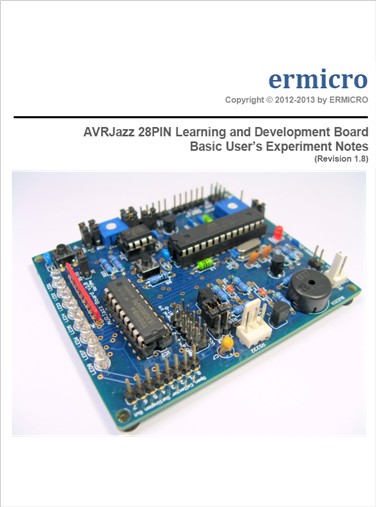Welcome to ermicroblog
Sunday July 13, 2025Are you looking for something fresh, update and simple explanation on the microcontrollers and electronics concept?
Here at ermicroblog we always bake fresh new projects,
tutorials, and ideas. Any sugestions and comments would be most welcome.
Have a pleasure reading and hope you enjoy visiting ermicroblog.
Feature Video
July 2017 Top 10 Pageviews
e-Book
Basic User’s Experiment Note

The “Basic User’s Experiment Note” is based on the popular 8-bit Atmel AVR ATmega328P microcontroller using AVRJazz 28PIN development board. This ebook covering most of the Atmel AVR ATmega328P microcontroller features and it’s aimed for the beginners, hobbyist, or anyone who wants to learn and understand the 8-bit Atmel AVR ATmega328P microcontroller powerful features. Read more »
Latest Entry
Developing Embedded Application with BASIC Language on the Microchip PIC18F Microcontroller using the Amicus18 Development system
Saturday December 24, 2011 by rwb, under Microcontroller.
The BASIC (Beginners’ All-purpose Symbolic Instruction Code) language has been known as one of the popular high level language choice in embedded system today. In fact the born and development of the personal computer (PC) we use today has been influenced by the used of BASIC language. Today there are many of professional BASIC language development tools variant targeting the Microchip PIC microcontroller.
No Comments
Interfacing the Microchip PIC18F Microcontroller Master Synchronous Serial Port (MSSP) to various I2C Devices
Sunday December 11, 2011 by rwb, under Microcontroller.
The Inter-Integrated Circuit or I2C (read as I square C) bus has been introduced in 1980 by Philips, and has become a de-facto world standard for data exchange between Microcontroller and various devices such as temperature sensor, ADC (analog to digital converter), DAC (digital to analog converter), I/O expander, EEPROM, and many more. With more than thousand different IC devices have been manufactured with an I2C-bus interface, making the understanding of the working principle of this I2C bus is an essential knowledge that has to be acquired by anyone who want to involve in the embedded world professionally or just as hobbyist. Read more »
No Comments
The Line Follower Robot with Texas Instruments 16-Bit MSP430G2231 Microcontroller
Sunday September 11, 2011 by rwb, under Robotics.
When Texas Instruments (TI) introduced their new value line 16-bit microcontroller complete with the programmer and development board named MSP430 Value Line LaunchPad in the mid of 2010 for only USD 4.30 include the shipping cost, this make it as the cheapest programmer and development board platform that you could ever find in the market. Therefore the introduction of the MSP430 value line LaunchPad development board make a tremendous impact especially among the electronics hobbyist, students, and enthusiast because now the big boy (TI) is seriously taking part in the electronic hobbyist market and directly compete their 16-bit class value line microcontrollers to the 8-bit class microcontrollers which are mostly dominated by Atmel and Microchip. Read more »
31 Comments
Make Your Own Arduino Shield Cradle
Sunday July 03, 2011 by rwb, under Microcontroller.
One of the advantages with the open source software and hardware such as Arduino (based on Atmel 8-bit AVR ATMega328 microcontroller) is the enormous “add-on” hardware called “Arduino Shield” that we could easily expand the Arduino main board and turn it into many cool and useful embedded system applications e.g. DC motor controller, web server, wireless application, GSM/GPRS modem and many more. The Arduino framework is so popular that many vendors come with their new Arduino shield module design almost every year.
No Comments
Working with Atmel AVR Microcontroller Basic Pulse Width Modulation (PWM) Peripheral
Saturday April 30, 2011 by rwb, under Microcontroller.
Pulse Width Modulation (PWM) is a technique widely used in modern switching circuit to control the amount of power given to the electrical device. This method simply switches ON and OFF the power supplied to the electrical device rapidly. The average amount of energy received by the electrical device is corresponding to the ON and OFF period (duty cycle); therefore by varying the ON period i.e. longer or shorter, we could easily control the amount of energy received by the electrical device. The Light Emitting Diode (LED) will respond to this pulse by dimming or brighten its light while the electrical motor will respond to this pulse by turning its rotor slow or fast. Read more »
18 Comments
Quick and Efficiently Wiring Your Prototype Circuit Board
Wednesday February 02, 2011 by rwb, under Yet Another Tips.
Many times we need to quick wiring the electronic circuit on the prototype board (perforator board). One of the problems wiring this kind of prototyping board using the ordinary wire (PTFE insulated wire) is it become difficult and looks clumsy when the electronic circuit become complex, especially if we want to rewire the same terminal more than once. Read more »
5 Comments
The LM324 Quad Op-Amp Line Follower Robot with Pulse Width Modulation
Friday January 14, 2011 by rwb, under Robotics.
Designing a simple and yet functional Line Follower Robot (LFR) is always a fascinating and challenging subject to be learned, the LFR actually could be implemented in many ways start from a simple two transistors to a sophisticated PID (Proportional, Integrate and Differential) which take advantage of the programmable feature of microcontroller to calculate the PID equation to successfully navigate the black track line on a white background surface. Read more »
110 Comments
ermicroblog pages
Home | Login | Register | About
